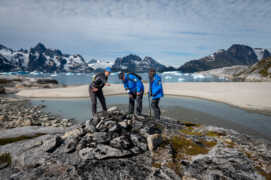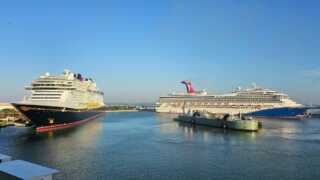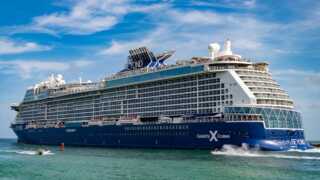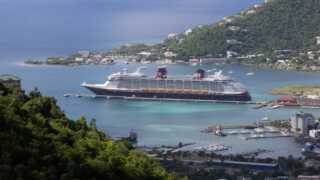Squinting in the chilling Arctic wind, I climb out of a small inflatable Zodiac and step onto the wet sand of Disco Island off the west coast of Greenland in Baffin Bay. I trudge up the hill where the rest of my group is already listening to our guide about the dos and don’ts of high-Arctic explorations, which can be summed up as “if you don’t want to be eaten by a polar bear, stay within the designated perimeter.” Everyone agrees that it’s reasonable and we proceed further up, intrigued by the promise of seeing flowers blossoming in the permafrost. When we find them, we buzz with kidlike delight. Who would’ve thought things can bloom here? Spotting polar bears and flowers are good reasons to be excited, but I have more. I am cruising with Adventure Canada, and Margaret Atwood, the famous Canadian writer, poet, and my favorite author, is trekking up the permafrost too. As a friend of the family that owns Adventure Canada, she had joined their northern voyages fairly regularly over the last few decades. She even wrote a fiction story, “Stone Mattress,” on one of these expeditions, in which main character Verna, a cruise passenger, runs into a man who got away with sexually assaulting her when she was 14 — and settles the score by killing him on an uninhabited Arctic island. I’ve always wanted to see the Arctic’s majestic beauty, but I wasn’t sure I could brave the elements. Learning that my favorite author, who is in her 80s, would be on the ship sealed the deal. As a writer who occasionally publishes short stories and has a novel in progress, I’d love to talk to Margaret on authorly topics, but I’m too chicken to strike a conversation. I just hope serendipity will intercede as we keep exploring. The Arctic Kaleidoscope Every moment of our journey is filled with wonder. As we sail up north, we visit the village of Mittimatalik, where we learn about Inuit culture and history, and enjoy a cultural performance which includes throat-singing, a traditional form of Inuit vocal art. Another day, we offload at Beechy Island, tracing the ill-fated expedition led by Sir John Franklin in 1845 that perished mysteriously; traversing the Arctic back then was a dangerous endeavor. As I get accustomed to the weather, I challenge myself to a kayak adventure in the frigid waters. That requires sealing myself inside a dry suit and climbing into a shifting and bobbing kayak from the Zodiac in the freezing rain. Next, we listen to safety instructions. We’re going to paddle along a beautiful glacier, which means we must watch out for ice that occasionally breaks off and falls into the water, generating no small waves. If that happens, we must quickly position our kayaks facing that wave to avoid capsizing. The prep proves useful — on our way back to the ship, a chunk of ice calves off, plummeting into the sea. Luckily, by then we’re far enough that the wave peters out when it hits us. Calving ice can pose danger even on land, as we learn on our visit to a Greenland village of Ilulissat. The village sits next to the Ilulissat Glacier, a large ice sheet that regularly generates enormous icebergs, setting off veritable tsunamis. On our hike to the glacier, we pass by a waterfront where a warning sign directs us to keep away from shore to avoid being swept away by an unexpected mega-wave. We heed the warning, wondering what Arctic tsunamis are like. Later that afternoon, we get to experience a small one in action, as we traverse the Ilulissat Icefjord. Large cruise ships typically don’t navigate the fjord’s relatively shallow waters, and Zodiacs are too little to withstand the calving waves, so we board a midsize boat for the trip. As we sail through the majestic labyrinth of floating white mountains glowing in the sun, the pristine silence is suddenly shattered by a roaring sound, a cross between…. By Lina Zeldovich
This is only an excerpt. To see the full feature, subscribe to Porthole Cruise and Travel Magazine.
Appeared first on: Porthole.com




